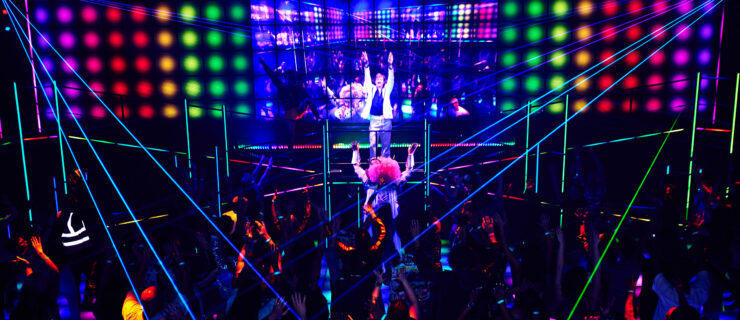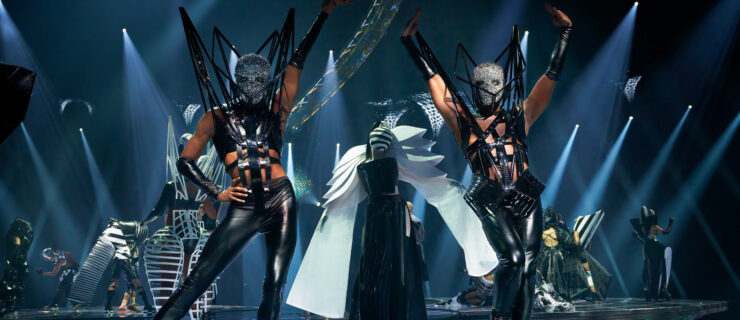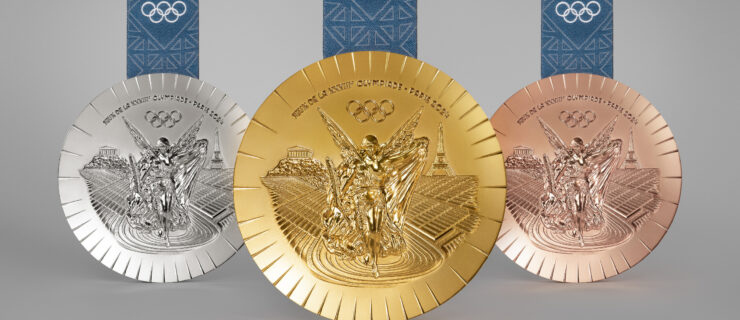Musicality Matters: How to Become a More Musical Dancer
When Lorena Feijóo took the stage in Jerome Robbins’ In the Night at New York’s City Center last October, it was as if an invisible cord connected her body to each instrument in the orchestra. Whether from studying the piano as a young dancer in Cuba or from her intrinsic ability to embody sounds, the San Francisco Ballet principal exhibits that intangible quality that makes dance such a pleasure to watch: musicality.
So what exactly is musicality? It’s how a dancer expresses music in his or her body. “Musicality is understanding music on a technical level, and then dropping all of that knowledge so you can sit deep inside the music,” says choreographer and “So You Think You Can Dance” regular Wade Robson. “It’s dancing inside the music, as opposed to floating on top of it.”
A well-developed sense of musicality separates the pros from the amateurs. It also makes you enjoyable to watch—and it’s a more rewarding way to dance! Here are some ways to hone your ear and make inspired music and movement choices of your own.
Mastering Musicality
Put a musical dancer and a nonmusical dancer side by side and you’ll see why it’s so important to be attuned to the rhythm, melody and mood of a song. Dancers without a keen connection to the music might seem stiff or disconnected—often, they’re hard to watch. “They’re unable to transmit the emotion the musical notes are giving,” Feijóo says. “A strong but nonmusical dancer is like a painting without any colors. I’d rather watch a musical dancer with less extension and not-as-pretty feet.”
Musical dancers, on the other hand, never disregard the music to fit in more tricks. “You can see the effort in a nonmusical dancer—they are often step-driven,” says NYC ballet teacher Deborah Wingert. “Musical dancers don’t just turn until they stop. They turn until they have to move on to the next point in the music. Musical dancers never get so caught up in steps that they ignore the music.”
It’s important to understand that musicality comes in many forms, and there is no right or wrong way to interpret a score. Some choreographers create entire dances before they choose the music, while others may start with a piece of music before they create a single step. As a dancer, you must be ready for any approach they use.
For example, Wingert remembers that when she danced for New York City Ballet, George Balanchine and resident choreographer Jerome Robbins had very different musical sensibilities. “Balanchine wanted us to be right on top of the music. We anticipated the music so when we were in the air, we hit the height of the note at the height of the jump,” she explains. “Jerome Robbins wanted his dancers to be under the music, a little more weighted, rather than right on the beat.”
To start working on your musicality, “do your barre work in a musically accurate way,”

says Oregon Ballet Theatre principal Anne Mueller. “It starts from the moment you begin dancing. Don’t slide through the music in tendu combinations, for instance. Making sure that you’re clear in your execution will give you more options because you’ll be able to take advantage of the still space; musicality can be as much about when you’re not moving as when you are.”
Phrasing Philosophies
If you’ve ever discussed musicality with a teacher or other dancers, you’ve probably heard a lot about “phrasing.” But do you know what it is? Musical phrasing is the way music is organized within measures. Where are the syncopations? The cadences? The accents? Choreographic phrasing is similar—it’s how steps are organized within a musical phrase. Which steps hit on the beat, and which move through the rhythm? Should one step be performed quickly so another can be stretched out?
Sometimes choreographers will specify the way their steps should be phrased, but when it’s allowed, experimenting with phrasing can give you multiple ways to dance a piece. In fact, the better you know a score or song, the more you’ll be able to play with the dynamics and timing of the steps—instead of always dancing right on a square beat, which can make you look repetitive and boring. Perhaps you can hold a développé for an extra moment or change the tempo of your movement to squeeze in another battu. “A dancer must have an excellent sense of rhythm to hold the audience’s attention,” says Feijóo. “Without getting off the beat, find where you can balance longer or fit one more turn. This is how you translate the mood the music gives you into the steps.”
To see how this works, watch two ballerinas dancing the same classical role (like Kitri in Don Quixote or Odette/Odile in Swan Lake). Even though the choreography and music are identical, each dancer will have her own unique way to fit the two together.
Honing Your Ear

Dancers who are trained to play instruments—like Robson and Feijóo, who both studied the piano—have a head start when it comes to developing musical sensitivity. But that doesn’t mean you’re doomed if you don’t know the difference between a treble clef and a bass clef. NYC choreographer Stephen Petronio, for instance, doesn’t read music and never learned to play an instrument, but he’s known for creating intensely musical work. Since he started making dance 25 years ago, Petronio has choreographed to composers like Stravinsky and collaborated with artists like Rufus Wainwright, Lou Reed and, most recently, Nico Muhly. “I can know within the first 15 seconds of listening to a piece if I can move to it,” Petronio explains. “The hair stands up on my arms, and I have to dance.”
So how did he hone his musicality if he had no formal training? With a little bit of natural intuition and a whole lot of practice. Petronio spends hours listening to many genres of music. He even chooses to choreograph to music that challenges him. Follow his lead and seek out complex scores—don’t be intimidated. Thorny, syncopated music will force you to listen more carefully, exercising your brain’s musicality muscle.
Consider formally studying an instrument whose sound moves you. If that’s beyond your budget, attend concerts. Many cities offer free performances in public parks. Check out your town’s event calendar and tap into the local music scene. You should also take a look at your playlists. Do you gravitate toward one genre? To expand your horizons, try exploring other types of music, especially jazz and classical.
Learning to differentiate instruments will help you translate what you hear into movement, which will, in turn, give your dancing shade and texture. If you don’t know the difference between a clarinet and an oboe, start with musical works like Sergei Prokofiev’s Peter and the Wolf or Benjamin Britten’s Young Person’s Guide to the Orchestra, both of which break down each instrument in a symphony so you can learn to distinguish sounds. Another way to hone your ear is to listen to recordings of the same score with different conductors and identify the differences between them.
Robson swears by this exercise, which he picked up from his days dancing with Michael Jackson: Find a song you like and listen to it as you normally would. “Just take it in,” Robson says. Then play it again, but listen only to the drum. Block out every other sound and follow the drum through the entire piece. Does it change? Does it stay the same? Play the song a third time, focusing on another instrument, like the piano. Repeat this exercise until you’ve followed every instrument in the song.
“You might have to listen 20 times, depending on the complexity of the song,” Robson says. “The last time you listen, take in the whole song again. You’ll be able to hear both the instruments individually and the tune as a whole. And you’ll be able to freestyle and dance to rhythms you never heard before. It will change your life as a dancer.”
Counting on Counts
When you’re breaking down a piece of music, do you find yourself counting it out or just listening to the general flow of the song? Dancers often have strong feelings about counting, and they don’t always agree. Sometimes counting is necessary, especially in corps work or when working with complicated scores. But fixating on counts can make your dancing seem mechanical.
Some choreographers may not count at all. If you find yourself struggling not to count, look for other musical cues to help guide you. For example, does a turn finish at the height of a crescendo? Does the choreography follow the bass line instead of the melody?
The more comfortable you become with the music, the easier it will be not to count, so make it your goal to learn the music well enough to stop counting. “Some ballets you might need to count at first, but after you’re secure, you won’t need that anymore,” Feijóo says. “And that will give you freedom to interpret, because you aren’t just following the beat or the melody.”
Too Much of a Good Thing?
While it’s good to have your own ideas about music and movement, be prepared to set your aesthetics aside. In an audition or when learning a new work, every professional must be able to hear and interpret the music exactly the way the choreographer wants.
Imagine if the ensemble in Chicago chose to dance according to their personal convictions. How about the corps in Swan Lake? There would be musical anarchy! Even if you’re a soloist, you may be expected to carry out a choreographer’s specific version of musicality. It takes just as sensitive an ear to perform another person’s vision as it does to choose your own interpretation of the music. “Sometimes I mirror movement and music exactly, and sometimes I ignore it,” says Petronio. “Sometimes I use it as a counterpoint.” Your job is to be ready for anything.
It’s also important to be aware of when and how your face expresses the emotion in the music. Some choreographers will want you to use your face; others will want you to let your body do all the emoting. Wingert recalls struggling with this idea when she was dancing in Balanchine’s Serenade with New York City Ballet. “It’s such beautiful music that you want to embody the drama of it,” she says. “I had to work on not overemphasizing the drama in my face and letting the dance embody the music”—because that’s the way Balanchine wanted it.
So how will musicality ultimately affect your movement? Nuance. You’ll be able to hear the subtleties in a score and interpret them with your body, and that will make you more interesting to watch. It’s also more fun. As Feijóo says, “I would be miserable if I had to dance without sound. Dancing is making music with your body.”



